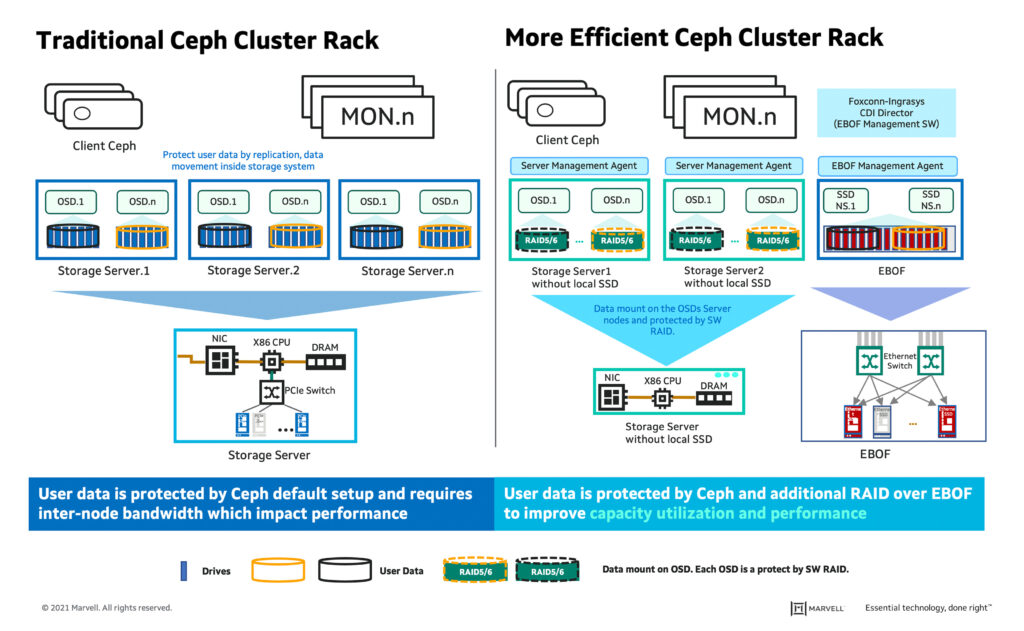

By Khurram Malik, Senior Manager, Technical Marketing, Marvell
A massive amount of data is being generated at the edge, data center and in the cloud, driving scale out Software-Defined Storage (SDS) which, in turn, is enabling the industry to modernize data centers for large scale deployments. Ceph is an open-source, distributed object storage and massively scalable SDS platform, contributed to by a wide range of major high-performance computing (HPC) and storage vendors. Ceph BlueStore back-end storage removes the Ceph cluster performance bottleneck, allowing users to store objects directly on raw block devices and bypass the file system layer, which is specifically critical in boosting the adoption of NVMe SSDs in the Ceph cluster. Ceph cluster with EBOF provides a scalable, high-performance and cost-optimized solution and is a perfect use case for many HPC applications. Traditional data storage technology leverages special-purpose compute, networking, and storage hardware to optimize performance and requires proprietary software for management and administration. As a result, IT organizations neither scale-out nor make it feasible to deploy petabyte or exabyte data storage from a CAPEX and OPEX perspective.
Ingrasys (subsidiary of Foxconn) is collaborating with Marvell to introduce an Ethernet Bunch of Flash (EBOF) storage solution which truly enables scale-out architecture for data center deployments. EBOF architecture disaggregates storage from compute and provides limitless scalability, better utilization of NVMe SSDs, and deploys single-ported NVMe SSDs in a high-availability configuration on an enclosure level with no single point of failure.

Ceph is deployed on commodity hardware and built on multi-petabyte storage clusters. It is highly flexible due to its distributed nature. EBOF use in a Ceph cluster enables added storage capacity to scale up and scale out at an optimized cost and facilitates high-bandwidth utilization of SSDs. A typical rack-level Ceph solution includes a networking switch for client, and cluster connectivity; a minimum of 3 monitor nodes per cluster for high availability and resiliency; and Object Storage Daemon (OSD) host for data storage, replication, and data recovery operations. Traditionally, Ceph recommends 3 replicas at a minimum to distribute copies of the data and assure that the copies are stored on different storage nodes for replication, but this results in lower usable capacity and consumes higher bandwidth. Another challenge is that data redundancy and replication are compute-intensive and add significant latency. To overcome all these challenges, Ingrasys has introduced a more efficient Ceph cluster rack developed with management software – Ingrasys Composable Disaggregate Infrastructure (CDI) Director.
By Khurram Malik, Senior Manager, Technical Marketing, Marvell
As data growth continues at a tremendously rapid pace, data centers have a strong demand for scalable, flexible, and high bandwidth utilization of storage solutions. Data centers need an efficient infrastructure to meet the growing requirements of next-generation high performance computing (HPC), machine learning (ML)/artificial intelligence (AI), composable disaggregated infrastructure (CDI), and storage expansion shelf applications which necessitate scalable, high performance, and cost-efficient technologies. Hyperscalers and storage OEMs tend to scale system-level performance linearly, driven by the number of NVMe SSDs that plug into the system. However, current NVMe-oF storage target Just-A-Bunch-Of-Flash (JBOF) architecture connects fast performance NVMe SSDs behind the JBOF components, causing system-level performance bottlenecks due to CPU, DRAM, PCIe switch and smartNIC bandwidth. In addition, JBOF architecture requires a fixed ratio of CPU and SSDs which results in underutilized resources. Another challenge with JBOF architecture is the scalability of CPU, DRAM, and smartNIC devices does not match the total bandwidth of corresponding NVMe SSDs in the system due to the overall system cost overhead and thus, impacts system-level performance.
Marvell introduced its industry-first NVMe-oF to NVMe SSD converter controller, the 88SN2400, as a data center storage solution application. It enables the industry to introduce EBOF storage architecture which provides an innovative approach to address JBOF architecture challenges, and truly disaggregate storage from the compute. EBOF architecture replaces JBOF bottleneck components like CPUs, DRAM and smartNICs with Ethernet switch and terminates NVMe-oF either on the bridge or Ethernet SSD. Marvell is enabling NAND vendors to offer Ethernet SSD products. EBOF architecture allows scalability, flexibility, and full utilization of PCIe NVMe drives.
Copyright © 2026 Marvell, All rights reserved.
